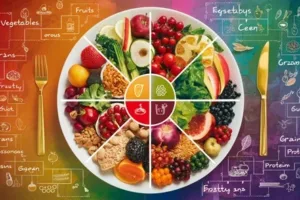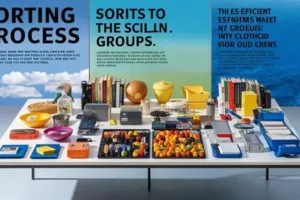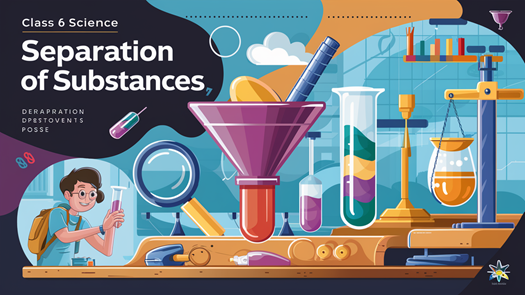
Class 6 Science Chapter 3 – Separation of Substances
What is the process for separating substances?
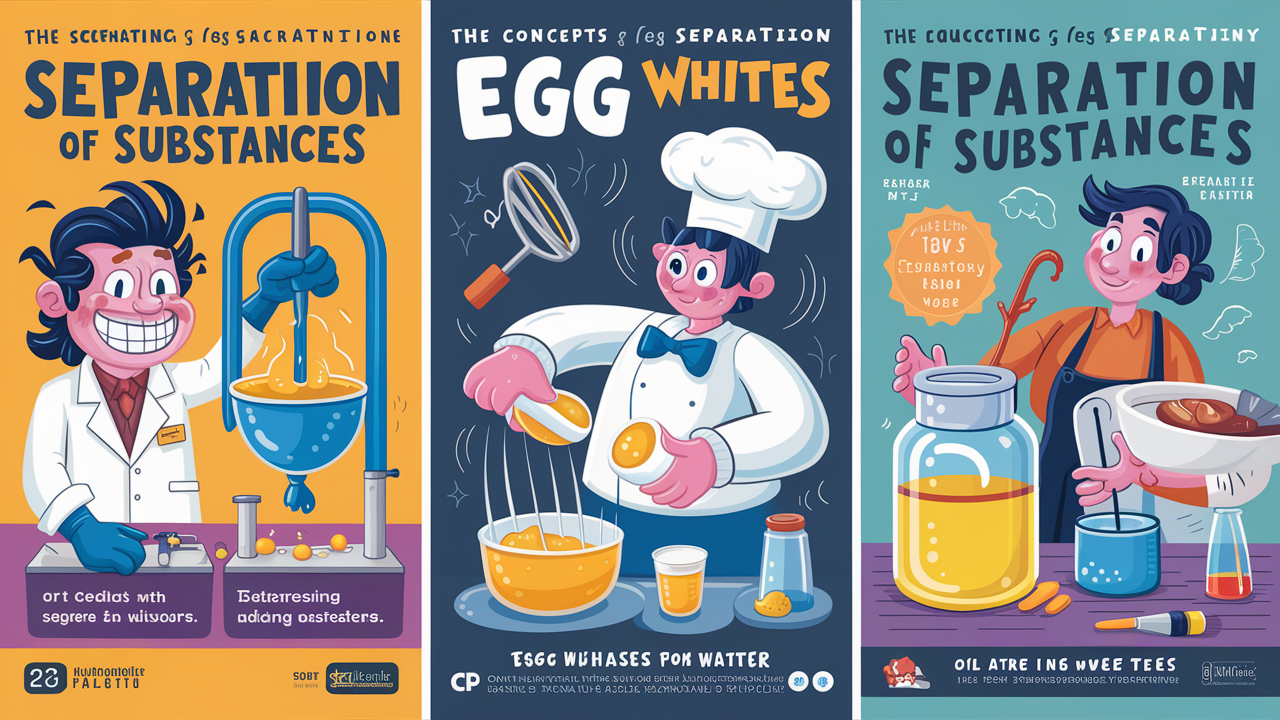
Separation of Substances is a fundamental concept in science that focuses on methods used to isolate and purify components from mixtures. This chapter is particularly relevant in educational curricula, such as Class 6 Science, where it serves to introduce students to basic principles of chemistry and material science. Understanding how to separate substances is essential not only in laboratory settings but also in everyday life, influencing processes in industries like food production, water treatment, and pharmaceuticals. The chapter outlines two main types of mixtures: heterogeneous and homogeneous. Heterogeneous mixtures contain visibly distinct components that can be easily identified and separated, such as salads or oil and water. In contrast, homogeneous mixtures have a uniform composition, where individual components are indistinguishable, exemplified by solutions like saltwater or soft drinks like Coca-Cola. The ability to distinguish and separate these mixtures forms the foundation of various scientific techniques and is crucial for practical applications in both academic and professional contexts. Separation techniques discussed in this chapter include methods such as filtration, evaporation, sedimentation, and distillation. Each technique is selected based on the physical properties of the substances involved, like particle size or solubility, allowing for efficient isolation of desired components from mixtures. Notably, advanced methods like chromatography and crystallization are also introduced, showcasing the evolution of separation techniques and their significance in modern science and industry. The chapter emphasizes the importance of these techniques in various fields, including environmental science, healthcare, and food production. Controversies may arise regarding the environmental impact of certain separation methods, particularly in industrial applications, where waste management and resource recovery are critical issues. By exploring the principles and applications of separation techniques, this chapter equips students with the knowledge to understand complex mixtures and their relevance in the world around them.
Types of Mixtures
Mixtures are broadly categorized into two types: heterogeneous mixtures and homogeneous mixtures.
Homogeneous Mixtures
In contrast, homogeneous mixtures consist of components that are uniformly distributed, resulting in a single-phase system where the properties are consistent throughout. Each part of a homogeneous mixture has the same characteristics, making it difficult to distinguish the individual components visually. An example of a homogeneous mixture is Coca-Cola, where the sugar and water blend seamlessly, creating a uniform solution.
Heterogeneous Mixtures
Heterogeneous mixtures are characterized by the presence of visibly distinct components, where the individual substances can be easily identified and separated. In these mixtures, the composition is not uniform throughout, meaning that different parts of the mixture have different properties. Examples of heterogeneous mixtures include salads, where the ingredients can be seen and separated, and mixtures of water and oil, where distinct layers can form due to differing densities.
Characteristics of Mixtures
Regardless of the type, mixtures maintain the individual properties of their components. They do not have fixed ratios by weight and can be separated by various methods based on physical properties such as particle size, density, and boiling point.. The separation techniques employed can include handpicking, filtration, evaporation, and distillation, among others. The ability to separate mixtures is crucial for various applications, ranging from everyday life to industrial processes, where the goal may be to remove impurities or isolate useful components.
Separation Techniques
Separation techniques are essential methods used to isolate and purify various components within mixtures. These methods are widely applicable across diverse fields, including chemistry, biology, and industrial processes, enabling scientists and engineers to analyze and manipulate materials effectively.
Types of Mixtures and Corresponding Techniques
The selection of a separation technique is primarily dependent on the nature of the mixture being processed.
Solid in Solid Mixtures
For mixtures consisting of solids, such as rice mixed with stones or husk mixed with grain, several techniques can be employed:
- Handpicking: This method is suitable for small quantities and involves manually picking out the unwanted component based on visible differences.
- Winnowing: Utilizes wind to separate lighter particles from heavier ones, commonly used in grain processing.
- Threshing: Separates the edible part of grain from the chaff.
- Sieving: Involves passing the mixture through a sieve to separate particles based on size
Solid in Liquid Mixtures
When solids are mixed with liquids, techniques such as the following are employed:
- Sedimentation and Decantation: In this process, heavier solid particles settle at the bottom of a container, allowing the clear liquid to be poured off.
- Filtration: This method uses a porous medium to separate solid particles from a liquid, commonly used in water treatment and laboratory settings
- Evaporation: Involves heating a liquid to transform it into vapor, leaving behind any dissolved solids. This technique is particularly useful for recovering substances from solutions.
Advanced Separation Techniques
In addition to the basic methods, there are several advanced techniques utilized in various fields:
- Crystallization: A technique used to form solid crystals from a solution, allowing for the purification of substances based on their solubility. This method is essential in pharmaceuticals and chemical manufacturing.
- Sublimation: This unique process directly converts a solid into a gas without passing through a liquid phase, making it useful for purifying compounds sensitive to heat.
- Chromatography: A widely used laboratory technique that separates components based on their different affinities for a stationary and a mobile phase, facilitating the analysis of complex mixtures.
Classification of Separation Methods
Separation techniques can also be classified based on the quantity of material to be processed or the physical and chemical phenomena they exploit. Some methods, like chromatography, are better suited for small samples, while others, like distillation, are designed for larger quantities. Moreover, techniques can be categorized into equilibrium processes, which rely on the balance of forces in a system, and rate (kinetic) processes, which focus on the speed of separation.
Applications of Separation Techniques
Separation techniques are vital across various fields, serving numerous applications that enhance both industrial processes and everyday life.
Industrial Applications
Chemical Industry
In the chemical industry, separation techniques are crucial for the production of various substances, including industrial gases, commodity chemicals, and pharmaceuticals. Traditional methods such as distillation, crystallization, and membrane processes are frequently employed to isolate valuable components from raw materials or to purify products for sale. For instance, in the production of monoclonal antibodies (mAbs), multiple separation methods are necessary to ensure safety and efficacy for pharmaceutical use, as impurities can cause adverse effects.
Water Treatment
One of the most significant advancements in separation technology is the use of membrane-based processes for water desalination. Reverse osmosis, which allows for the efficient removal of salt from water, has become the dominant method for new desalination plants due to its lower energy requirements compared to traditional evaporation techniques. Thousands of facilities globally now utilize this technology, which not only conserves energy but also improves water accessibility in arid regions.
Environmental Applications
Separation techniques also play a critical role in environmental science, particularly in waste management and pollution control. By effectively isolating valuable materials from waste streams, these technologies can reduce disposal costs and enhance recycling efforts. For example, the chemical industry often faces challenges in separating low-concentration contaminants from wastewater, where advanced separation methods can detoxify effluents while recovering valuable metal ions.
Health and Biomedicine
In healthcare, separation techniques are essential for drug manufacturing and biochemical research. They enable the purification of active pharmaceutical ingredients and the analysis of biological samples, thus contributing to advancements in medical treatments and diagnostic procedures. The ability to separate specific compounds from complex mixtures is fundamental to understanding biological processes and developing targeted therapies.
Food Industry
Separation methods are also widely utilized in the food industry, where they facilitate the extraction of flavors, colors, and nutrients from raw ingredients. Techniques such as filtration, centrifugation, and evaporation are commonly employed to produce a variety of food products, from juices to dairy items, ensuring quality and safety for consumers.
Engaging Classroom Activities
Introduction to Separation Techniques
Incorporating engaging activities in the classroom enhances students’ understanding of separation techniques through practical application and exploration. Teachers can utilize animations and virtual labs to provide an enriching experience that connects theoretical concepts with hands-on practice.
Virtual Lab Experience
One innovative approach is the use of virtual labs, such as Labster’s Separating Mixtures Virtual Lab. Here, students assist a character named Jo in producing bioethanol through a distillation experiment. This immersive activity allows students to apply their knowledge of phase changes, heating curves, and boiling points of different liquids in a virtual setting. Such interactive experiences not only stimulate curiosity but also empower students to become adept problem solvers.
Animation and Interactive Learning
Animations can serve as valuable teaching tools, especially when presenting separation techniques in a step-by-step manner—from simpler methods like filtration to more complex ones such as chromatography. Educators are encouraged to pause these animations at critical points, posing questions that encourage students to reflect and assess their understanding. This strategy promotes active engagement and facilitates deeper learning.
Suggested Activities
- Handpicking Activity: To illustrate the handpicking method, teachers can have students separate items such as small stones from grains. This practical demonstration allows students to visually grasp the differences in size and shape.
- Winnowing Experiment: Another hands-on activity could involve simulating the winnowing process by blowing air to separate lighter husk from heavier grain seeds, reinforcing the concept through real-life applications.
- Filtration Demonstration: Students can observe filtration by separating dirt from water using filter paper. This experiment can also extend to separating pulp from juice, providing a tangible understanding of this method.
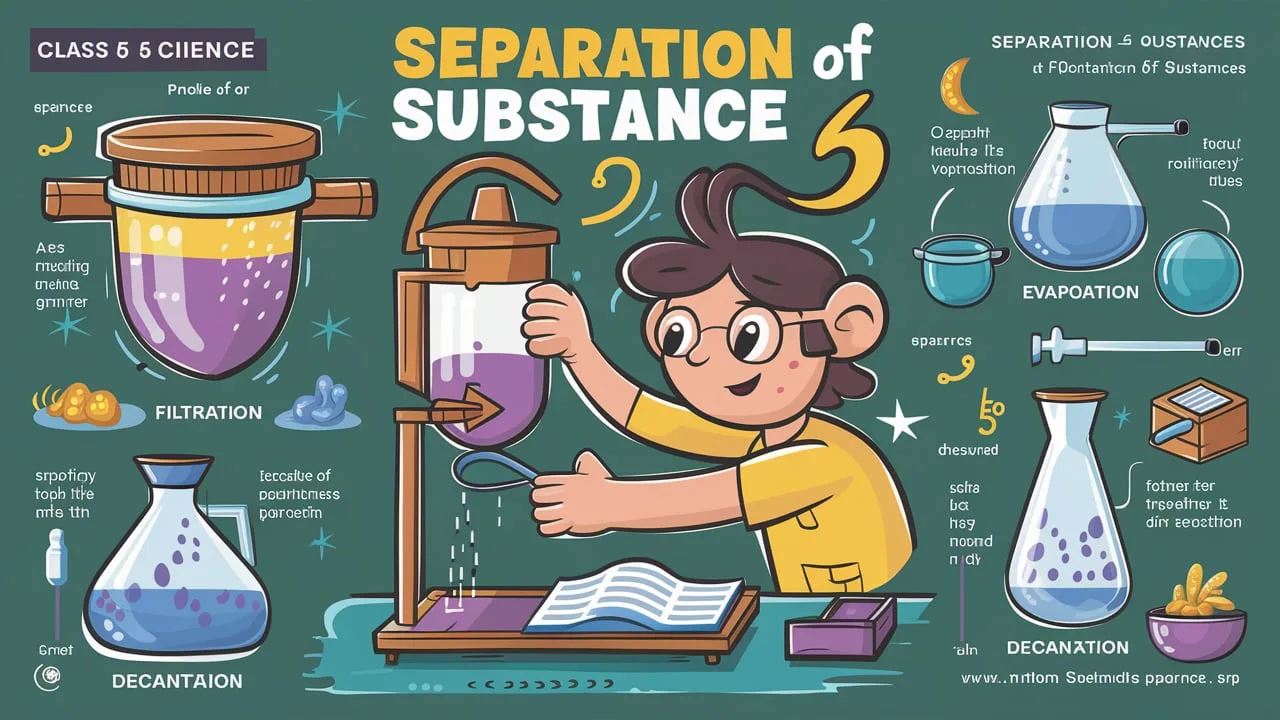
Exercise Questions
1. Why do we need to separate different components of a mixture? Give two examples.
Solution:
When two or more substances are mixed together, they form a mixture. Components of a mixture should be separated because some components may not be useful or may spoil the useful component of the mixture.
Examples: Tea leaves are separated from the liquid with a strainer while preparing tea. Removal of stone pieces from wheat, rice or pulses by hand.
2. What is winnowing? Where is it used?
Solution:
The method of separating the components from a mixture is known as winnowing. In this method, heavier and lighter components of a mixture are separated by wind or by blowing air. This method is used by farmers to separate lighter husk particles from heavier seeds of grain.
3. How will you separate husk or dirt particles from a given sample of pulses before cooking?
Solution:
Husk and dirt particles are separated from pulses by winnowing.
4. What is sieving? Where is it used?
Solution:
Sieving is a method in which fine particles are sieved through holes in the sieve while the bigger impurities remain on the sieve. Sieving is used in a flour mill to separate impurities like husk and stones from wheat before grinding it. It is also used at construction sites to separate pebbles and stones from sand.
5. How will you separate sand and water from their mixture?
Solution:
Sand and water are separated from their mixture by the following steps:
a) The mixture is allowed to stand without any disturbances.
b) Now, sand settles down.
c) Slowly pour the water into another container to obtain sand in the bottom.
6. Is it possible to separate sugar mixed with wheat flour? If yes, how will you do it?
Solution:
Yes, it is possible to separate sugar mixed with wheat flour by the following method:
a) Mix sugar and wheat flour in water.
b) Stir the solution to allow the sugar to dissolve.
c) Now, filter the mixture.
d) Filtrate contains the sugar solution, and the residue will be wheat flour.
7. How would you obtain clear water from a sample of muddy water?
Solution:
The following process should be carried out to obtain clear water from muddy water:
i) Allow muddy water to stand.
ii) Mud gets settled down in the water.
iii) Slowly pour water into another container.
8. Fill in the blanks.
(a) The method of separating the seeds of paddy from its stalks is called ___________.
(b) When milk, cooled after boiling, is poured onto a piece of cloth, the cream (malai) is left behind on it. This process of separating cream from milk is an example of ___________.
(c) Salt is obtained from seawater by the process of ___________.
(d) Impurities settled at the bottom when muddy water was kept overnight in a bucket. The clear water was then poured off from the top. The process of separation used in this example is called ___________.
Solution:
(a) The method of separating the seeds of paddy from its stalks is called threshing.
(b) When milk cooled after boiling is poured onto a piece of cloth, the cream (malai) is left behind on it. This process of separating cream from milk is an example of filtration.
(c) Salt is obtained from seawater by the process of evaporation.
(d) Impurities settled at the bottom when muddy water was kept overnight in a bucket. The clear water was then poured off from the top. The process of separation used in this example is called decantation.
9. True or false.
(a) A mixture of milk and water can be separated by filtration.
(b) A mixture of powdered salt and sugar can be separated by the process of winnowing
(c) Separation of sugar from tea can be done with filtration.
(d) Grain and husk can be separated with the process of decantation.
Solution:
a) False
b) False
c) False
d) False
10. Lemonade is prepared by mixing lemon juice and sugar in water. You wish to add ice to cool it. Should you add ice to the lemonade before or after dissolving sugar? In which case would it be possible to dissolve more sugar?
Solution: Ice should be added to lemonade after dissolving sugar. It is possible to add more sugar before adding ice.
Frequently Asked Questions (FAQs)
Q1. What is separation of substances?
A1: Separation of substances refers to the process of removing unwanted substances from a mixture or dividing the components of a mixture to make them useful. It helps in obtaining pure substances or separating two or more substances that are mixed together.
Q2. Why do we need to separate substances?
A2: We need to separate substances to:
- Remove harmful or non-useful components.
- Obtain useful substances from mixtures.
- Remove impurities to obtain pure substances for daily use, such as separating dirt from rice or wheat.
Q3. What are the different methods of separation?
A3: Some common methods of separation are:
- Handpicking: Separating large-sized impurities by hand.
- Threshing: Separating grains from stalks.
- Winnowing: Using wind to separate lighter particles from heavier ones.
- Sieving: Using a sieve to separate particles of different sizes.
- Sedimentation and Decantation: Settling down of heavier particles and pouring off the liquid.
- Filtration: Using a filter to separate insoluble solids from liquids.
- Evaporation: Removing liquid by heating to leave behind solids.
- Condensation: Cooling vapor to turn it into liquid.
Q4. What is handpicking? When is it used?
A4: Handpicking is a method of manually removing undesirable substances or impurities from a mixture. It is used when the substances to be separated are large in size, like stones from rice or pulses.
Q5. What is threshing?
A5: Threshing is the process of separating grains from the stalks. It is usually done by beating the harvested crop against a hard surface or using machines.
Q6. What is winnowing and where is it used?
A6: Winnowing is the method of using wind or air to separate lighter particles (like husk) from heavier ones (like grains). It is commonly used by farmers to separate grains from chaff.
Q7. What is the difference between sedimentation and decantation?
A7:
- Sedimentation is the process where heavier particles settle down in a liquid mixture after some time.
- Decantation is the process of gently pouring the liquid into another container after sedimentation, leaving the heavier particles behind.
Q8. What is filtration?
A8: Filtration is the method of separating an insoluble solid from a liquid using a filter. For example, separating tea leaves from tea using a strainer.
Q9. What is evaporation? Give an example.
A9: Evaporation is the process of heating a liquid to turn it into vapor, leaving behind solid particles. An example is obtaining salt from seawater by evaporating the water.
Q10. What is condensation? How is it related to evaporation?
A10: Condensation is the process where water vapor cools down and turns back into a liquid. It is the reverse of evaporation. When vapor rises and cools, it condenses to form droplets.
Q11. What is a solution?
A11: A solution is a mixture in which one substance is completely dissolved in another. For example, sugar dissolves in water to form a sugar solution.
Q12. What are solute and solvent?
A12:
- Solute is the substance that is dissolved in a solution (e.g., sugar in water).
- Solvent is the substance in which the solute dissolves (e.g., water in sugar solution).
Q13. Can all mixtures be separated by the same method?
A13: No, different mixtures require different methods of separation based on the properties of the components, like size, weight, and solubility. For example, handpicking is used for large impurities, while filtration is used for insoluble solids in liquids.
Q14. What is the importance of sieving?
A14: Sieving is used to separate fine particles from coarse particles. It is commonly used in homes and industries to separate flour from bran, sand from gravel, etc.
Q15. How do evaporation and condensation help in the separation of substances?
A15: Evaporation helps in separating a dissolved solid from a liquid by heating the liquid until it evaporates. Condensation helps in obtaining pure liquids by cooling down vapors back into liquid form. Both methods are essential in separating liquids and solids from solutions.
Also visit: Readspot

